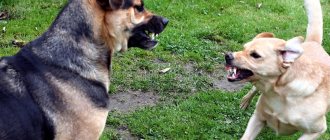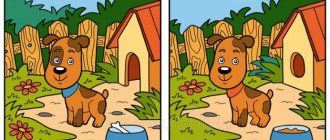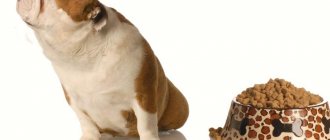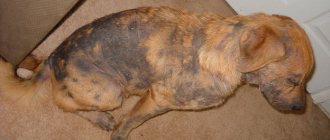Our Doberman, Sheila, suddenly started digging the floor in the apartment. She's almost a year old. It doesn't look like games. What could it be?
Sometimes dogs, as adults, suddenly start digging on the bed, in the yard, on the floor, in the bathroom. In a word, they begin “excavations” in the house. Dogs don't indulge in such entertainment for no reason. The following factors force them to dig:
- The desire to make a den. Perhaps the dog is not happy with the bed you built for him. Maybe he feels uncomfortable there, it’s cold. In nature, these animals make a den for themselves by crushing grass and digging holes in the ground. This is normal instinctive behavior. Sometimes the comfort of the bed itself is not as important to dogs as the ritual of its construction. But when a dog starts digging in the bed, this indicates that he is not confident in his own safety and cannot hide and be alone. The dog in such situations will dig the owner's bed in an attempt to make a safe den.
So, the owner must analyze which of the above reasons may push his dog to such actions. If it’s boredom and lack of physical activity, then provide your pet with active walks and give him the opportunity to run around to his heart’s content. Teach your dog prohibition commands to stop unwanted behavior in the house.
A dog of any breed, before lying down, performs a funny ritual: spins around, digs the bedding, lies down and gets up again. The duration and intensity of this obligatory “bed dance” depends on the breed, age and temperament of the animal. Why they do this, you will learn from this article.
The dog wants to make his “bed” softer
Professor Stanley Coren, who conducts neuropsychological research on the behavioral activity of dogs, has established a relationship between the degree of unevenness of the surface and the number of turns the dog makes before lying down. In the experiment, the behavior of sixty-two dogs was observed as they went to sleep on surfaces with different types of relief. The conclusion is clear - the longer the dog stomps on the bed, the more unevenness there is on the surface.
It turns out that the main meaning of the animal's circling is akin to shaking a sheet. These actions have one goal - to make the place where you spend the night comfortable for sleeping.
The distant ancestors of canines living in nature and their current wild relatives crushed the grass in this way and made the bed comfortable. At the same time, they scared away stinging living creatures - snakes, insects - from the place chosen for the bed.
The dog wants to defend himself
After trampling, the dog goes to sleep, most often curled up in a ball. This position ensures that the animal remains warm and safe. An animal sleeping in a cavity is more difficult for enemies to notice, and, in addition, the most vulnerable places on its body - the throat and stomach - are protected.
Maintaining the ball position on a flat surface is tiring; you have to constantly strain your muscles. A depression made in the ground or snow helps to relax, as the walls of the den support the back and serve as support for the body.
A healthy four-legged pet, after twirling and trampling, calms down and falls into a light “dog” sleep. The instinct of a guard and hunter will not allow the animal to sleep soundly - hearing and smell continue to work.
The dog doesn't feel well
If the dog cannot settle down for a long time, constantly gets up and lies down, you should be wary. The reason may not be related to instincts, but may indicate health problems with the pet. The dog may be suffering from arthritis or other neurological problems, especially if the animal is old. These animals, like people, suffer from joint pain as they age.
If a puppy or young dog behaves this way, then this is the result of stress. Stress can be caused by restrictions on freedom of movement, aggressive behavior of owners, and lack of attention.
Contact your veterinarian if you notice changes in your pet's behavior and habits.
So, in ancient times, the ancestors of dogs circled and dug the ground, creating rookeries in order to ensure a comfortable and safe rest. This habit helped to survive and adapt to the harsh conditions of life in the wild. This behavior is called adaptive; it remains in the memory of descendants at the level of instincts, even after it has lost its meaning.
What to do if your dog digs in the bed? Resign yourself, educate or look for reasons for special behavior? Let’s make a reservation right away: if you find torn sheets or a torn pillow, don’t hesitate to scold your ward; perhaps the reason is not a desire to fool around, but absolutely natural needs.
If he looks in the mirror
Reflection like a dog
“A dog cannot perceive its reflection. The dog looks into the mirror, which means he sees otherworldly guests in it.”
In fact, both cats and dogs can see the reflection. Young puppies, learning about the world, often bark at the mirrors, but quickly realize that you can’t make porridge with the enemy on the other side of the glass (there is no smell, you can’t pat him by the withers) and lose interest. Observe your pet's behavior. If your dog looks into all reflective surfaces - shop windows, a shiny car door, oven glass - then you have got an incorrigible explorer who has retained a puppyish interest in life. Does the dog single out only one mirror and ignore the rest? Then the question remains of how he behaves. He looks calm, snorts and wags his tail - there is nothing to worry about. Growls and barks? Try removing the object that is bothering your dog from the house or replacing it with a different mirror.
How to stop a dog from digging in the bed
Even the most loving owners are unlikely to put up with torn sheets, blankets or even damaged mattresses. Many owners react sharply to the presence of hair and saliva on their bed linen... and this is not surprising. Does your dog dig in the bed and you have decided to eradicate this habit? Be patient - it is possible, but it will require enterprise and time.
Let us immediately state that it is impossible to wean a dog from survival instincts , and if you try, most likely you will traumatize the pet’s psyche. Basically, there are three options:
- Come to terms with it.
- Strictly monitor the dog and do not let it near the bed, and if you overlooked it, accept it.
- Redirect your pet's actions in a peaceful direction.
We are only interested in the last option, and in order to begin implementing it, we need to complete a number of preparatory measures. Provide a comfortable, quiet and, if necessary, closed place for your pet to sleep. Some dogs don't feel safe without a roof; to remedy this problem, you can buy or make a makeshift canopy.
Taming instincts: how to wean a dog from gnawing and digging
A dog's upbringing and natural instincts determine its behavior throughout its life. We try to develop some habits to the level of correct behavior, while others we try to eradicate. Instincts “Dig and gnaw!” belong to the category of those that dog breeders are trying to fight. It is quite natural for a small puppy to taste and taste everything that comes his way. First, he is teething, and in this way he tries to alleviate his suffering. Then the puppy begins to explore the world and tastes everything. And then it develops into a habit that is very difficult to break. But do not rush to punish the puppy for something that is not his fault. If he wants to chew, let him chew, but not just anything, but special treats for dogs and toys, which should be enough to distract the puppy’s attention from your things. As soon as you notice that your dog is chewing everything in sight, take action. Remove from the puppy's field of vision those objects that may be of interest to his curious nature - shoes, books, wires, household appliances, a trash can, small objects that can be swallowed. The fewer temptations, the better. Teach your puppy to chew only objects specifically designed for this purpose. Typically, dog owners use toys made of dense and elastic material for this, or a special treat, Denta Stix®, which can be given to puppies from the age of four months. Changing teeth in puppies can be accompanied by itching. Never let your puppy scratch its teeth on your old clothes or shoes, even if you were going to throw them away! The child’s mind should develop a “taboo” against other people’s things. It is necessary to train the puppy to chew only permitted objects, and this rule also applies to adult dogs. You must teach your dog to properly entertain himself and achieve error-free behavior without leaving him unsupervised. It often happens that a dog chews things even despite the presence of the owner. An untrained animal does not yet know your rules, so getting angry at its misdeeds, much less punishing it, is useless. It is better to teach your dog the correct behavior and monitor it. If this is not possible, then when leaving home, leave the dog where it will not cause damage to property. It’s just important to leave her with plenty of interesting, permitted toys that will keep her entertained until you return.
Puppies and young dogs can also chew everything if they do not receive the required amount of vitamins and minerals from their food. The best way to feed puppies is a combination of dry and wet diets. You can read more about this in our article, and our application will help you choose the appropriate diet for your baby and adjust it. It is also necessary to monitor the health of your dog's teeth. After changing teeth, you can evaluate your pet's oral health using the app.
To dig or not to dig? That's the question... For your pet, the answer is obvious: digging, of course. And it takes a lot of effort to wean a puppy, and sometimes an adult dog, from this habit. If a dog digs in the country house or in the garden, it is quite possible that in this way it is trying to fight boredom. Another reason why a puppy digs so persistently in the ground is natural curiosity.
To wean your pet from digging, spend time with him and take walks more often. Teach him games he can play in your absence. Educational toys are very good in this regard and will occupy the puppy’s attention for a long time. In the summer, dogs most often begin to dig in order to get to the cool layers of the soil, thus trying to hide from the heat. Build a corner for your puppy that is protected from direct sunlight. Then he will have no reason to seek protection from the heat and heat elsewhere. But it is quite possible that the habit of digging is an innate instinct of your pet. After all, many dog breeds were bred specifically for hunting foxes or other burrowing animals. In this case, give the puppy a place in the yard where he can satisfy his instincts. Teach him to dig only here and nowhere else. And so that the dog is not tempted to do this in other places, waylay him in the process and, after expressing indignation, punish him by lightly patting him at the withers. As a last resort, spray the ground in the prohibited area with a special product - the sharp and unpleasant smell will scare away the puppy. And reward your dog if he digs where you allow him to. The habit of digging and gnawing is a consequence of the dog’s natural instincts, which are very difficult to fight. But nothing is impossible for a good owner; the main thing is to sincerely love your pet and be consistent in your actions.
To dig means to mark
A very important nuance of dog psychology that every owner needs to understand. If a pet stubbornly digs the floor, blanket, mattress, she considers this item to be her sleeping property. Having scratched the blanket, the dog marks it and don’t be surprised if it tries to steal property or looks at you with an uncomprehending look when you once again pray to the dog gods. Scratching the floor, digging the bed, things, bedding - this is a “symptom” of infringement. Your pet has no property and is forced to appropriate what seems suitable to him.
Another nuance is that between the dog’s toes there are glands that secrete a secretion with an individual smell. When the pet scratched the sheet, he marked it with a scent. This scent is stronger than yours (to the dog) and has more meaning. You can get rid of the markings by washing or treating them with fragrances, for example, if your pet has appropriated a sofa, carpet or bulky blanket.
Important! Remember to speak to your coachee and explain your motivation in an appropriate tone. When the leader of the pack says: “This is mine, you can’t, ugh!” A well-mannered dog understands that it is laying claim to someone else's property. If your cries are ignored, consider whether you are the “leader”.
Why does the dog hide under the sofa?
Contents hide
Why does the dog hide under the sofa?
Cats were usually seen in something similar - these animals, in moments of danger (real and imaginary), always huddle in some kind of shelter. It’s hard to blame dogs for cowardice! Nevertheless, such behavior patterns do occur: the dog fearfully hides in a secluded place (for example, under a sofa or bed) and watches the development of events from there. Why is this happening? Fear? Something else? Let's think and reason.
Maybe it's even nice? First let's assess the situation. Were there any moments that could have caused fear or fright? Nothing like this even came close, and the dog, not without pleasure, climbs under the sofa - it is possible that he is simply comfortable there. Let's turn to the nature of these animals - they love to set up “dens” for themselves, where they feel relatively safe. At home, the space under the sofa can also serve as a den! We need to think logically about what exactly led the pet to this behavior: the house is noisy, annoying children, someone is constantly squeezing its paws. And even other, no less “harmful” and “annoying” pets.
Fear. Also an important reason. Actually, in moments of danger, a dog has two options: accept the challenge (that is, get into a fight) or run away. What exactly will your dog choose? It’s hard to say, depending on what the “threat” is. Does it come from a naughty child? The dog will be able to stand up for itself and demonstrate a defensive response. Another thing is unknown external threats: thunder, fireworks, other sharp sounds. Most likely, the pet will prefer to hide. The space under the sofa is small and relatively dark - ideal conditions to feel safe and calm. Observe the animal's body language: you will see flattened ears, a tail between the legs, hear a warning growl - it is better not to approach.
Fears and phobias in dogs, as a rule, are formed at a young puppyhood. For example, you could train your puppy using a spray bottle and splashes of water. This is enough for a phobia to develop. Every time you pick up a bottle of water (just drink it), the animal will experience severe fear.
It is possible that in the first days and even weeks, an adult dog that you have just brought into the house will find refuge under the sofa. Don’t be surprised if the period of adaptation to a new home and new people takes place there. Be patient!
Learned behavior. Puppies are undoubtedly cute and adorable. Happy owners tend to forgive them many pranks, like little children. What a disservice they are doing to themselves. As you know, dogs are very observant; they can read faces. One day, a puppy, playing explorer, crawled under the sofa. A wave of emotion swept across your face - what a great guy! You petted your pet and gave him something tasty. The kid immediately learned: I just did a very good thing! The method of positive reinforcement worked here too, but in the wrong direction.
What to do? In many cases, there is no need to do anything - the dog climbed under the sofa, sat and crawled out. You never know - suddenly he wanted to be alone. But sometimes a small correction is required - especially when the pet is completely out of control and begins to show destructive patterns of behavior. You can start by using radical methods - rearrange the sofa or sofa so that it becomes impossible to climb under it. At the same time, you will have to start training: the dog needs to be practically re-accustomed to obedience and discipline. Start with basic commands. Determine a place for your pet, train him to take this very place on command. The positive reinforcement method can help you! How to do it? Prepare some treats. Give them exactly when the dog is in his “place”. Encourage him, pet him, show him how pleased you are. Soon the dog will develop positive associations. At the same time, you can spray the scent of bitter apple under the sofa - it is unpleasant for most dogs, but harmless. Whenever any other behavioral problem arises, first try to find its root causes; then think about what you can counter. Plus patience, methodical and systematic work!
Original: Why Does My Dog Hide Beneath the Sofa? Source: cuteness.com Photo: pixabay.com











